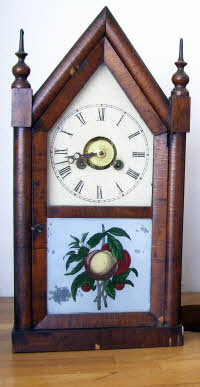
American Antique Mantel Clock Collection
A little history of American Mantel Clocks
Of all the styles of clocks mantel clocks (sometimes mantle clocks or shelf clocks in USA) are particularly attractive to some antique mantel clock collectors because, having been mass-produced, they are sometimes inexpensive to buy.
Mantel clocks were made to stand on mantelpieces and tables: they were not meant to stand on the floor. A great variety of antique mantel clock styles exists, most having been manufactured by Connecticut makers, commencing with Eli Terry who made his first, wooden clocks around the beginning of the 19th century. These Box Case clocks evolved into the popular and much copied Pillar and Scroll style (1820). This style of mantel clock was followed by the extremely popular Looking Glass Clock which Chauncey Jerome, of Bristol, Conn. claimed to have invented. These clocks were cheap to make and gave the buyer the satifaction of having two products (a mirror and a clock) for the price of one!
The Looking Class style of mantel clock evolved into the largest selling style of Connecticut clock -the OG clock - so-called because of the ogee shape of the wooden moulding of the case. This design used a rolled-brass movement which was very cheap to mass-produce, and is probably the first example of mass-produced, factory-based production in America: the labels inside these mantel clock cases sometimes proudly show the factories themselves. These clocks helped revive the economy after the depression following the War of Independance and were produced in huge quantities (by e.g. Chauncey Jerome) right up to the First Word War. Many were exported. The New Haven Clock Company began (1853) by making movements for the Jerome Manufacturing Company. Nowadays these antique mantel clocks are very collectable.
The OG style of mantel clock was weight driven (hence the large height), but with the development of springs for motive power the size of clocks could be reduced and the variety of styles increased. Elias Ingraham developed the very popular Steeple (Gothic) style clock around the middle of the 19th century. Initially these were "waggon-spring" clocks, the springs being housed in the lower part of the "double-decker" cases. Antique mantel clocks in this style are now very much sought after... later (and more commonly found) came the coiled spring style (as is the Steeple mantel clock in my collection). Many designs followed, including, for example, the Bee-hive and Round Gothic styles.

New Haven antique mantel clock: alarm: 1920’s?
This attractive little antique mantel clock was bought in a junk shop in Wales. The face gives the "NEW HAVEN" provenance and it claims to be "COMPENSATED" although I can see no evidence of this in it's basic movement. There is no other lettering other than "MADE IN U.S.A". It's balance wheel movement runs with a satisfying, if irregular, tickety TOCK, tickety TOCK sound!

New Haven Clock Company antique mantel clock: steeple: alarm: 1890’s?
This was the first real antique mantel clock I bought.
Sometimes these "Steeple Clocks" are called "Sharp Gothic" reflecting their architectural/cabinet-making style. This one has turned finials suggsting it is not an early model (which were conical in form). The painting is on the reverse side of the glass. Inside is the alarm bell and label. (Note: in the photo the (plain) pendulum has been removed to show the label).

Jerome & Company antique mantel clock: striking: date unknown
I think this is rather an impressive antique mantel clock: behind the rear-painted glass there is a pendulum which is attempting to simulate a sophisticated mercury-bearing pendulum. The bell is behind the pendulum. There is a partly damaged label on the rear of the case with the words "1 Day VICTO..", "STRIKING", "JEROME &.." and "NEW HAVEN, CONN,..". There follows brief instructions re. regulating and setting the clock, cautioning about moving the hands past a chiming point (re. the "warning"? Sorry, I'm no horologist but I do understand that something significant happens just prior to a clock striking!).
Like many such mantel clocks the case here uses an exotic veneer (mahogany, rosewood etc.) glued onto a pine frame.

Jerome & Company antique mantel clock: striking: 1910’s?
Chauncey Jerome claimed he started importing these OG (ogee) clocks into the UK in 1843 - I have even heard these large, 30 hour striking clocks were sometimes called "kipper boxes" because they arrived in England packed into the holds of ships like so many boxes of fish!
An attractive feature of these mantel clocks is the transfer applied/ stencilled picture on the lower glass panel- in this case it is a river scene showing the launching of a boat. Inside the case are the two weights which drive the clockwork and striking trains. Collectors of antique mantel clocks usually appreciate the labels inside the cases - Here is this clocks label.
There are some clocks in my European antique mantel clock collection worth seeing if you like American mantel clocks: they were produced to emulate the American clocks (even "impersonate" them!):
 -
-  -
-  -
-  -
- 
Take a look at large pictures and information about these clocks in my European Antique Clock Collection.